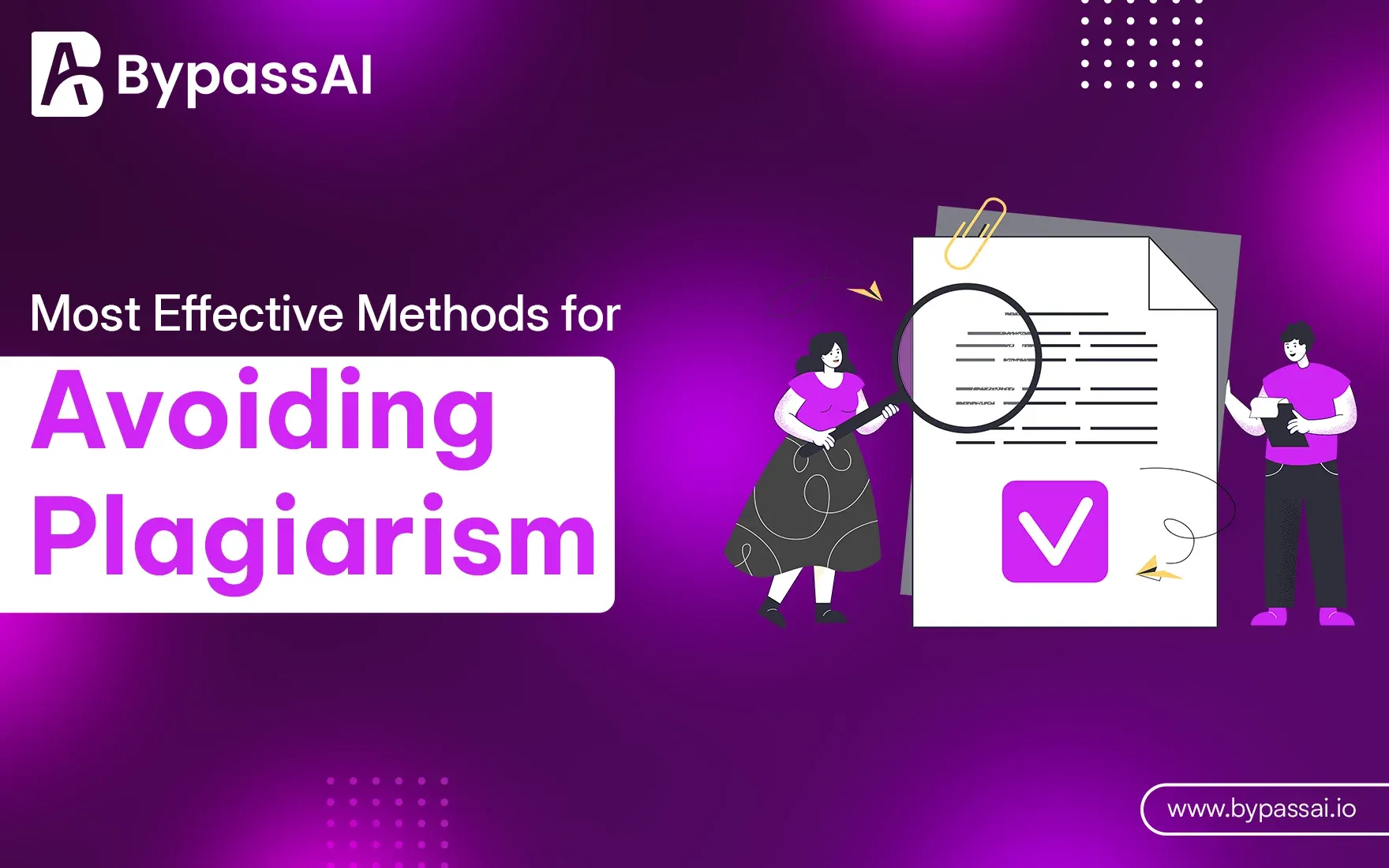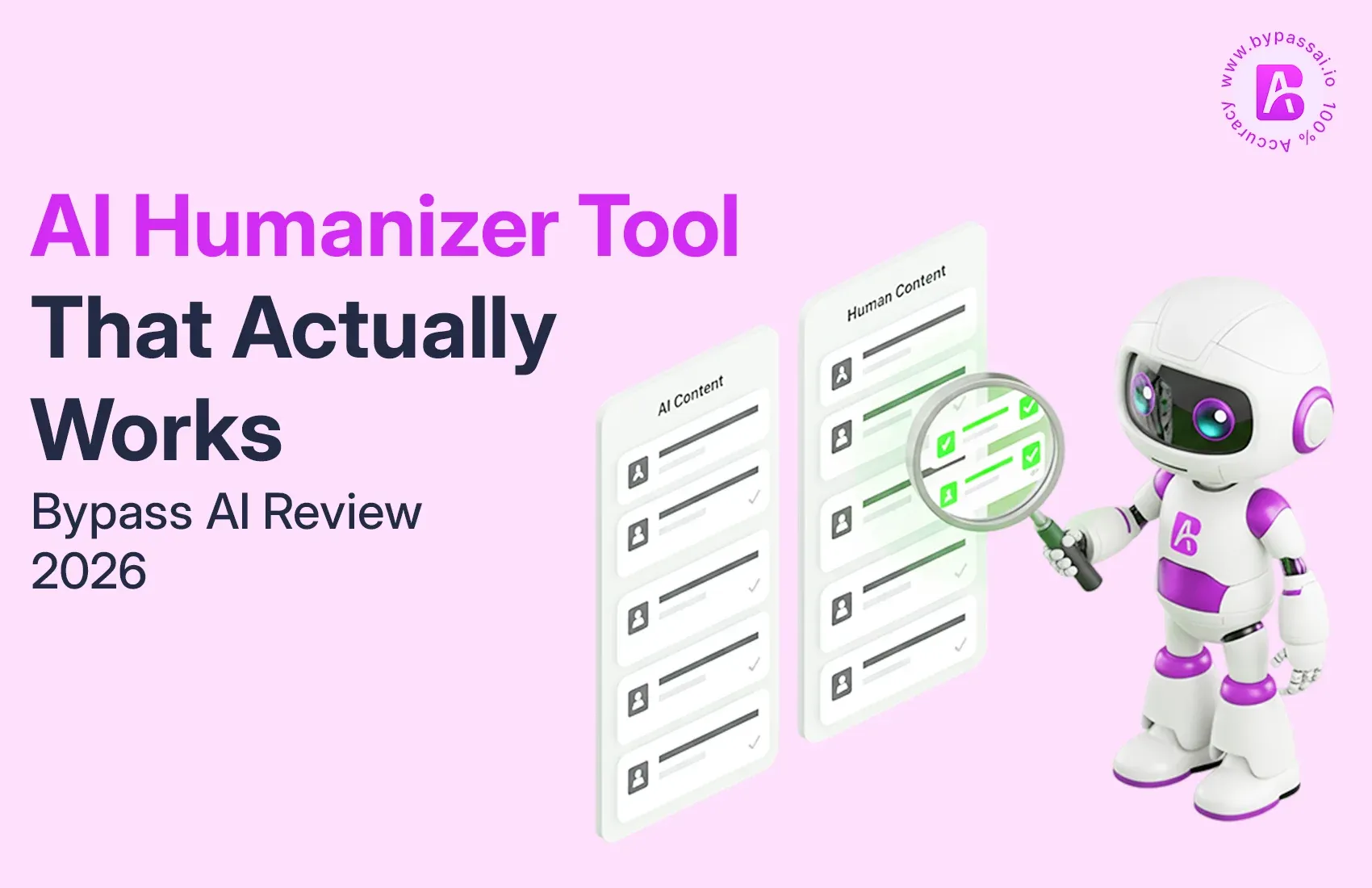Sign In
Welcome to Bypass AI! Sign in to continue your exploration of our platform with all its exciting features.
Forgot Password?
Don’t have an account ? Sign up
Sign Up
Embrace the Future with Bypass AI! Sign up now and let's rewrite the possibilities together.
You have an account ? Sign In
Enter OTP
We’ll send you an OTP on your registered email address
Back to Login
Forgot Password
We'll Send You An Email To Reset Your Password.
Back to Login
Enter OTP
We'll send you an email to reset your password.
Back to Login
Confirm Password
Please enter your new password.
TABLE OF CONTENTS
Quick Summary
What is plagiarism?
Why should you avoid plagiarism?
What are the 3 types of plagiarism?
10 ways to avoid plagiarism in your writing
Conclusion
FAQs
In today’s information-rich world, the risk of plagiarism is greater than ever. Whether you’re a student, a professional writer, or anyone else involved in the creative process, it’s important to understand how to avoid plagiarism. Stealing is not only an academic error but also a violation of ethical standards that can have serious consequences. This guide explores what plagiarism looks like, why it’s important to avoid it, and offers ten practical ways to ensure your writing is original and credible
Quick Summary
It should be used without appropriate reference to another person’s work or opinion. It can be intentional or accidental, but the consequences are always serious. Avoiding plagiarism is essential to maintaining academic integrity, teaching excellence, and honoring original authors. This guide outlines ten effective ways to prevent plagiarism, including citing good sources, using quotations, paraphrasing, providing original ideas, using a plagiarism detector, understanding what not to cite, adding references, organizing your work, checking for plagiarism before submitting, and a book a comprehensive list of types. By following these strategies, writers can create authentic and credible work that reflects their own understanding and creativity.
What is plagiarism?
Plagiarism is the use of another’s ideas or information without giving due credit. Plagiarism can range from unintentional (you forget to include a source in the bibliography) to intentional (buying a paper online, using another author's ideas as your own to make your' the work has seemed tricky) Both beginners and experienced writers can plagiarize. Understand that plagiarism is a serious charge in academia, but also in professional settings.
Why should you avoid plagiarism?
Plagiarism should be avoided for a variety of reasons. For one, it is dishonesty. Simply put, presenting another writer’s work as your own is fake.
Another reason to remove plagiarism is that you learn nothing from plagiarizing someone else’s work. When your instructor assigns a presentation, you are expected to make an honest effort to engage with the topic you cover, use critical thinking, and demonstrate the ability to advance your standing, though pointed out, and well defended eat An original essay, flaws and all, . show your teacher how you progress in their class And where you might need some extra help.
It is also disrespectful to the original author. Writing is work, and it can sometimes be very hard work. Claiming someone else’s work as your own gives you undeserved credit, as well as proper recognition for their hard work
What are the 3 types of plagiarism?
Plagiarism comes in many forms. These three types of plagiarism are the most common:
1. Direct Plagiarism
Direct plagiarism is similar to complete plagiarism in that it, too, is the overt passing-off of another writer’s words as your own. The difference between the two is how much of the paper is plagiarized. With complete plagiarism, it’s the entire paper. With direct plagiarism, specific sections or paragraphs are included without crediting (or even acknowledging) the author.
An example of direct plagiarism is dropping a line or two from your source directly into your work without quoting or citing the source.
2. Self-Plagiarism
You might be surprised at what you can steal yourself.
how? But your original ideas are your own to use as you please . . . . . .right?
Yes, but with caution. Let’s say you wrote an article about the pros and cons of changing your city’s zoning code a couple of years ago, and now you’re writing a paper about the ten-year-old status of some local codes that have been adopted in the past and have been added to other cities. You can absolutely use the same information and if you quote correctly, you don’t have to worry about being accused of plagiarism.
When you write work professionally, plagiarism can be an issue. If you’re hired to write for a client, the client owns that job. Reusing your content for later clients is stealing your business and can damage your professional reputation (and make your client look bad).
3. Direct copying
This is the most obvious. And the name explains everything. It uses someone else’s work without changing it at all and without citing sources.
10 ways to avoid plagiarism in your writing
Fortunately, it’s not all that terrible. Avoiding plagiarism is really easy because you have a beginning understanding of what it is. Here’s how to get away from this taboo and avoid plagiarism in your writing.

1) Mention your source
If you are citing ideas or words that are not your own, include a citation in your text stating the full source, dates of publication, and any additional citations by author you rely on the search.
2) Include quotations
If you insert words from a source word for word into your text, a simple but obvious way to avoid plagiarism is to surround the text with quotes to indicate that the words are not w 'own of Also cite direct sources to let readers know who is being quoted from .
3) Paraphrase
Do not copy word by word the notes from the presentation sheet. Instead, rephrase the idea in your own words. Understand the concept(s) of the reference source thoroughly in order to interpret correctly.
4) Present your own idea
Instead of portraying the source’s opinion or information, find out what they say about it. Ask yourself what unique perspectives or perspectives you can use to contribute to your totally personal writing. Keep in mind that even if you are citing the source’s shapes or words to edit your content, you will still need to apply the guidelines above to avoid plagiarism
If you're writing the same topic across multiple assignments, it can be tempting to recycle your previous material—this is called "plagiarism." The risk of plagiarism is equally high if the publisher or your instructor did not give you permission to reuse the old work.
5) Use a plagiarism checker
Most universities use plagiarism detection software like Turnitin to detect potential plagiarism. Here’s how plagiarism checkers work: they scan your paper, compare it to a database of web pages and books, and highlight paragraphs that look like other pieces of writing
Consider using plagiarism to check yourself before you send your order. This will help you identify issues that could lead to accidental theft, e.g.
Forgotten or misplaced quotes Missing quotations A hybrid that looks too much like the original text
Then you can easily prevent possible theft.
Also read this article : Top 12 plagiarism checker Tools in 2026
6) Know what not to cite
It’s definitely “overquoting” rather than “undersitting”.
but…
To know when to cite sources, you also need to understand what you don’t need to cite. You don’t have to quote logic or facts about famous stories. Personal experiences and urban legends fall into that category.
However, there is one thing to remember, and that is copyright. While literal meanings or facts cannot be privileged, original words or unique words can. So even if you’ve got well-known facts, be very careful and explain them in your own words.
7) Add references
The reference list contains all the functions you cited in your paper.
Reference lists also have a specific format, so you need to make sure you use proper style guidelines. Because the list contains specific information, it is important to ensure that any details are correct. Information in the annotation list includes the author’s name, publication date, title, and source. The accuracy of those listings and the availability of additional information is determined by the citation method you use (as noted above).
8) Plan your work well before starting to write
With a thoughtful and thoughtful plan for the future of your career, you will be able to balance everything far better.
You can determine how much of your own ideas will appear in your paper and how much you intend to borrow from other writers.
The plan will also determine whether or not you’ve got all the primary sources you need for the project.
9) Check your work before submitting it
As mentioned, there are many tools on the market for plagiarism analysis. Tools like Grammarly offer free preliminary testing. Other advanced prepaid offerings are also on the market. They offer advanced algorithms and an extensive literature archive. We recommend Scribbr’s plagiarism checker which uses the same software and database used by universities.
10) Write your bibliography
Remember how we talked about how to take notes when highlighting your products?
You will need those notes to organize your books. And the sooner you start writing, the better. In fact, as soon as you start packing up your paper supplies—right before is a good time to start.
Taking notes as you go will be very beneficial to your paper success. You can see what sources are missing and what still needs to be discovered. It will also help to make sure you have complete notebooks that properly document all sources.
If you decide not to use any of your source material when editing, you can always remove sources from your list.
Conclusion
Plagiarism is an important issue that can have significant impacts both academically and professionally. Understanding how to avoid theft is essential to maintaining integrity and trust in your business. By using these ten strategies, you can ensure that your writing is original, attributed, and respectful of others’ opinions. Whether you’re a student, a teacher, or a professional writer, adopting these practices will help secure an authentic and credible career. Remember that the key to successful writing is not only articulating ideas but also giving proper credit to sources that inspire them. For a reliable tool to help detect and prevent plagiarism, check out Bypass AI's Plagiarism Checker.
FAQs
1. What is considered theft?
In plagiarism, appropriate credit is not given for the words, ideas, or actions of another. Copying, non-acceptance of retelling, even plagiarism, where one can reuse one’s earlier work without revealing it, can take a variety of forms.
2. How do I check for plagiarism in my business?
You can use various plagiarism detection tools like Turnitin, Grammarly, and Scribbr’s plagiarism checker to check your work. These tools compare your information to a large database of published works and highlight similarities.
3. What are some common misconceptions about stealing?
A common misconception is believing that changing a few words in the source will prevent plagiarism, thinking that citation is not necessary, and thinking that self-plagiarism is not a concern and it is important to understand these nuances to avoid accidental theft.
4. How can I improve my ability to deliver new feedback?
Improving paraphrasing involves mastering the original text and then expressing ideas in your own words. Practice reading a passage, summarizing, checking, and comparing your translation to the original to ensure accuracy and originality.
5. Why is it important to quote correctly?
Quality citations are important because they give credit to the original authors, allow readers to search for sources, and demonstrate the research basis of your work. It also helps avoid plagiarism by distinguishing your ideas from those of others clearly.




